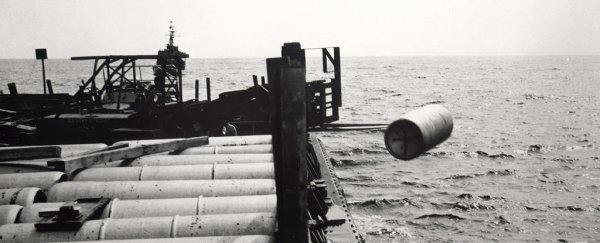There's thought to be at least 1 million tonnes' worth of chemical weapons littering the ocean floor – the buried legacy of two World Wars – and scientists have warned it's likely to pose a "significant threat" to marine life.
The risk is due to the metal on these dumped munitions rusting away, releasing the chemicals they contain, and poisoning underwater ecosystems. Of course, that's going to affect anyone who relies on these ecosystems, which means pretty much all of us.
Scientists from across Europe, supported by NATO's Science for Peace and Security (SPS) program, have worked for three years to set up monitoring equipment and collect data in the Baltic Sea.
Their research – called the Monitoring of Dumped Munitions (MODUM) project – is intended to work out just how dangerous these chemical spillages could be, using a combination of Autonomous Underwater Vehicles (AUVs) and Remotely Operated Underwater Vehicles (ROVs).
With the data already collected, the researchers will evaluate the status of habitats in the region, conduct studies of fish health, and run computer modelling on possible threats to nearby areas.
Part of the challenge is we're not sure where a lot these chemicals actually are. Many were dumped into the ocean at the end of World War II in bomb casings, artillery shells, and barrels, but nobody made detailed records of what went where, and it was often done in secret.
And while some countries specifically looked for the deepest water they could find, with US chemicals despatched in areas with a minimum depth of 1,800 metres (5,906 feet), others weren't so careful: the Soviets unloaded around 15,000 tonnes of material in the Baltic Sea, which has a maximum depth of only 459 metres (1,506 feet).
In total, the NATO experts think that there are about 50,000 tonnes of chemical weapons in the Baltic, and they say if just a sixth of that leaks, the underwater habitat in the area could be ruined for a century.
Right now, scientists aren't sure exactly how these chemicals will leak, or the ultimate effects they'll have.
But previous studies published in Environmental Science & Technology in 2010 and Clinical Toxicology in 2015 both concluded that the risk to marine life and humans is real and needs a lot more investigation, which is what MODUM hopes to provide.
While we wait on more findings, the danger is already starting to surface, with reports of mustard gas washing up off the coast of Delaware in recent years.
Then there's the scary tale of a group of Polish fishermen in 1997. As described by Andrew Curry at Hakai magazine, after pulling a chunk of frozen mustard gas from the water, four of the crew had to be hospitalised with burns and blisters.
Disposing of these kinds of harmful chemicals in the ocean has been illegal since 1972, thanks to the London Convention, but the MODUM team have their work cut out for them in addressing the dumping that took place in the decades before.
Let's hope their research can come up with solutions before more people, animals, and ecosystems are put at serious risk.
"It's a global problem," Terrance Long, chair of the International Dialogue on Underwater Munitions (IDUM), told Hakai. "It's not regional, and it's not isolated."
